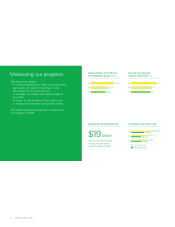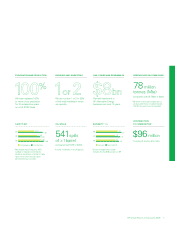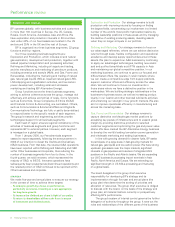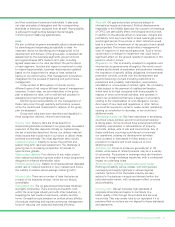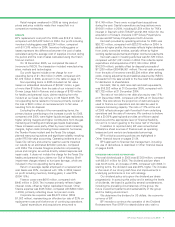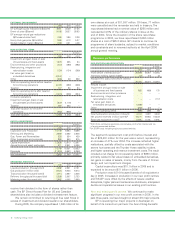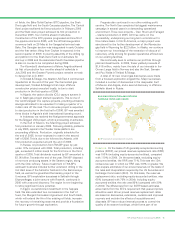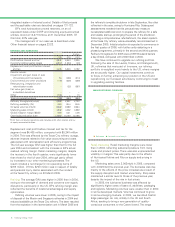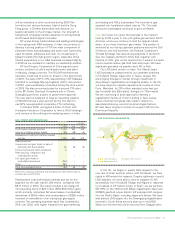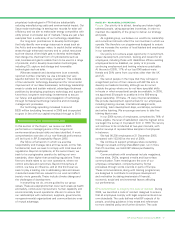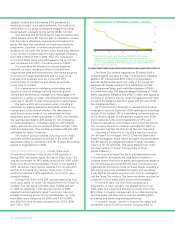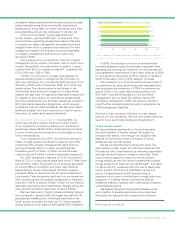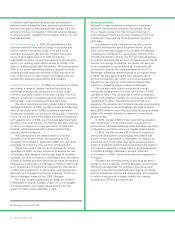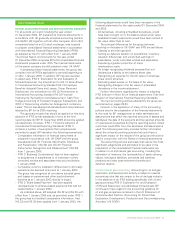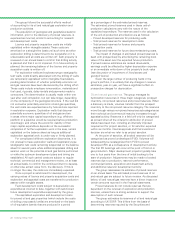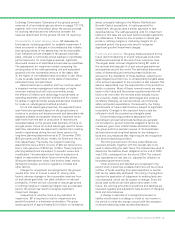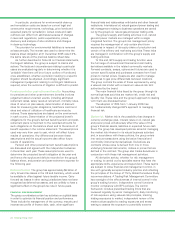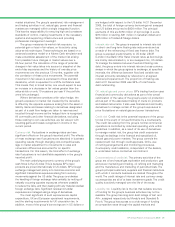BP 2005 Annual Report Download - page 18
Download and view the complete annual report
Please find page 18 of the 2005 BP annual report below. You can navigate through the pages in the report by either clicking on the pages listed below, or by using the keyword search tool below to find specific information within the annual report.
16 Making energy more
its start-up, expected in 2008. Tangguh will also supply
gas into new terminals in Fujian, China, and Baja, Mexico.
In 2005, we made good progress in the construction of
China’s first LNG import facility in Guangdong, where
BP is a joint-venture partner. When the facility becomes
operational in 2006, gas will be supplied from the NWS
partnership (BP 16.7%) in Australia.
We continue to be the largest NGLs marketer in the
US. Our capacity utilization was well above plan, despite
disruptions to supply following the summer’s Gulf of Mexico
hurricanes. Full operations at our joint venture NGLs plant
in Egypt started in the first quarter of 2005 and the plant
reached full gas processing capacity of close to 1.1bcf/d
in the second half of the year.
BP Alternative Energy In 2005, we announced the launch
of BP Alternative Energy, a business dedicated to the
development and wholesale marketing and trading of
low-carbon power. We believe we have sufficient new
technologies and sound commercial opportunities within
our reach to build a significant and sustainable business in
alternative and renewable energy. BP Alternative Energy will
manage a first phase of investment of around $1.8 billion
during the next three years, the first part of our aim to
invest $8 billion over 10 years. This first-phase investment
will be spread in broadly equal proportions between solar,
wind, hydrogen and high-efficiency gas-fired power
generation. The business will initially employ around 2,500
people. It will bring together the group’s existing activities
in these technologies with our power marketing and trading
capabilities to form a single business. In solar, our sales
grew by 6% in 2005, and continued to generate profits. We
are committed to doubling our manufacturing capacity of
solar cells between 2004 and the end of 2006. In 2005, we
successfully completed the Frederick solar plant expansion
in Maryland, US. We also signed a joint venture agreement
with Xinjiang SunOasis Company, a leading photovoltaic
module manufacturer and system supplier in China.
We completed the construction and commissioning of
our 9MW Amsterdam wind farm, and applied for planning
permission for 10 turbines at the BP fuel terminal on the
Isle of Grain, UK, to generate 18MW of power.
We finalized all the commercial agreements and
commissioned the first unit of K-Power’s 1,100MW gas-fired
power plant in South Korea, where we have a 35% interest.
We successfully started commercial operations at our
wholly owned 50MW combined heat and power plant in
Hythe, UK, which supplies steam and electricity to local
industrial customers. We sold our 100% interest in the
Great Yarmouth 400MW gas-fired power station to RWE
in November 2005 for $282 million. At the end of 2005,
two new co-generation projects in North America, with
capacity totalling over 700MW, were in the early stages
of development.
In June 2005, together with our partners, we
announced plans for the development of the world’s
first large project to generate electricity from hydrogen,
while reducing CO2emissions and enhancing oil recovery
in the North Sea. The hydrogen will be used at a power
station in Peterhead, UK, to generate 350MW of ‘clean’
electricity and the CO2reinjected into the offshore Miller
field. Work has begun on the front-end engineering design
stage, addressing significant technical challenges that we
believe we and our partners are well placed to manage. At
the same time, we are keeping under constant review the
schedule of the project and its commercial viability, which is
itself dependent on clarification of the regulatory regime.
OTHER BUSINESSES AND CORPORATE
$ million
2005 2004 2003
Profit (loss) before interest and taxa(1,191) 164 (253)
Inventory holding (gains) losses 5 (8) 1
Replacement cost profit (loss) before
interest and tax (1,186) 156 (252)
Results include:
Impairment and gain (loss) on sale
of business and fixed assets 38 1,164 139
Environmental and other provisions (278) (283) (213)
Restructuring, integration and
rationalization costs (134) (102) 5
Fair value gain (loss) on
embedded derivatives (13) – –
Other 3 66 549
Total non-operating items (384) 845 480
aProfit from continuing operations and includes profit after interest and tax
of equity-accounted entities.
Other businesses and corporate comprises Finance, the
group’s aluminium asset, interest income and costs relating
to corporate activities, and also the portion of O&D not
included in the sale of Innovene to INEOS. This includes
the equity-accounted investments in China (the SECCO
petrochemicals complex) and Malaysia (Polyethylene
Malaysia Sdn Bhd and Ethylene Malaysia Sdn Bhd). The
result includes a net charge for non-operating items of
$384 million, of which $278 million is in respect of new, and
revisions to existing, environmental and other provisions.
TECHNOLOGY
Technological innovation and know-how are central
to our strategy and performance. Technology is vital in
converting resources to reserves and meeting the needs
of our customers.
We aim to align our technological activities with our
business strategy, focusing on areas where BP can create a
distinctive advantage. When we adopt new technologies we
spread them as rapidly as possible through the group and
apply them on a large scale. We aim to use the best talent
inside and outside BP to develop and apply technologies.
Our five-year technology plan is intended to maximize
our ability to access increasingly complex oil and gas fields,
to develop better products for our customers – often by
using alternative low-carbon technologies – and to improve
our day-to-day operations continuously.
We are a world leader in advanced seismic imaging,
from discovery through to field development and
management, and a world-class formulator for creating fuels
and lubricants that better meet customer needs. We have


